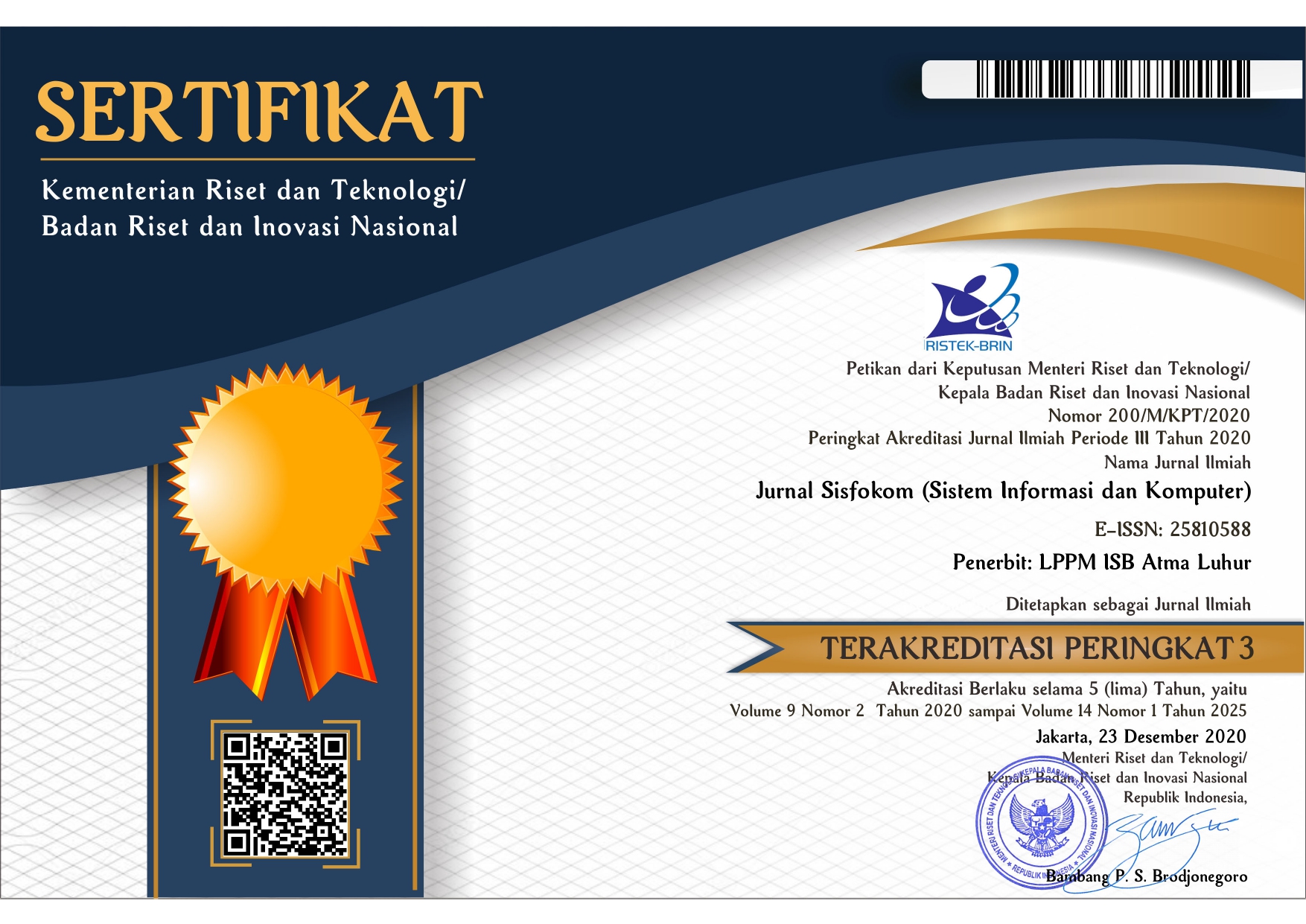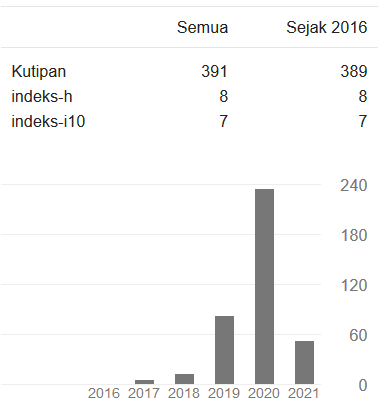Does The Lecturers’ Innovativeness Drive Online-Learning Adoption in Higher Education? A Study based on Extended TAM
DOI:
https://doi.org/10.32736/sisfokom.v13i2.2122Keywords:
lecturers’ personal innovativeness, perceived usefulness, perceived ease of use, TAMAbstract
Adoption and intention to use online learning is a developing area of education research. Despite a large body of research on online learning acceptance, more is needed to know about the factors that impact lecturers' intentions to continue utilizing online learning. The purpose of this study is to give empirical evidence regarding the acceptance of online learning. The proposed model is based on the technology acceptance model (TAM). Several hypotheses were created using the TAM Model, utilizing lecturers' personal innovativeness as an external varaibel. This study used structural equation modeling (SEM-PLS) to investigate technology use among 180 lecturers. The findings suggested that the proposed model accurately predicted the desire to continue using e-learning. Lecturers' innovativeness had a significant impact on perceived usefulness (PU), perceived ease of use (PEOU), and intention to continue using e-learning. Perceived usefulness was the most important factor influencing the intention to continue using e-learning. PEO had a significant influence on PU and PU was able to mediate the relationship between LPI and PEO with CI. However, PEO did not.References
F. D. Davis, “User acceptance of information technology: system characteristics, user perceptions and behavioral impacts,” International Journal of Man-Machine Studies, vol. 38, no. 3. pp. 475–487, 1993, doi: 10.1006/imms.1993.1022.
F. D. Davis, “Perceived Usefulness, perceived Ease of Use and User Acceptance of Information Technology,” MIS Q., vol. 13, no. 3, pp. 319–340, 1989, doi: 10.1016/S0305-0483(98)00028-0.
D. Gefen, “Reflections on the dimensions of trust and trustworthiness among online consumers,” ACM SIGMIS Database, vol. 33, no. 3, pp. 38–53, 2002, doi: 10.1145/569905.569910.
G. M. Bubou and G. C. Job, “Individual innovativeness, self-efficacy and e-learning readiness of students of Yenagoa study centre, National Open University of Nigeria,” J. Res. Innov. Teach. Learn., vol. 15, no. 1, pp. 2–22, 2022, doi: 10.1108/jrit-12-2019-0079.
A. F. M. Ayub, S. H. Zaini, W. S. Luan, and W. M. W. Jaafar, “The Influence of Mobile Self-efficacy, Personal Innovativeness and Readiness towards Studentsâ Attitudes towards the use of Mobile Apps in Learning and Teaching,” Int. J. Acad. Res. Bus. Soc. Sci., vol. 7, no. 14, 2018, doi: 10.6007/ijarbss/v7-i14/3673.
E. M. van Raaij and J. J. L. Schepers, “The acceptance and use of a virtual learning environment in China,” Comput. Educ., vol. 50, no. 3, pp. 838–852, 2008, doi: 10.1016/j.compedu.2006.09.001.
Y. J. Joo, H. W. Lee, and Y. Ham, “Integrating user interface and personal innovativeness into the TAM for mobile learning in Cyber University,” J. Comput. High. Educ., vol. 26, no. 2, pp. 143–158, 2014, doi: 10.1007/s12528-014-9081-2.
A. Amid and R. Din, “Acceptance and use of massive open online courses: extending UTAUT 2 with personal innovativeness,” J. Pers. Learn., vol. 4, no. 1, pp. 57–66, 2021.
E. J. Kim, J. J. Kim, and S. H. Han, “Understanding student acceptance of online learning systems in higher education: Application of social psychology theories with consideration of user innovativeness,” Sustain., vol. 13, no. 2, pp. 1–14, 2021, doi: 10.3390/su13020896.
R. Agarwal and J. Prasad, “Are individual differences germane to the acceptance of new information technologies?,” Decis. Sci., vol. 30, no. 2, pp. 361–391, 1999, doi: 10.1111/j.1540-5915.1999.tb01614.x.
E. M. Rogers, Diffusion of Innovations, 2nd ed. New York: The free press, 1983.
V. Singh and A. Thurman, “How Many Ways Can We Define Online Learning? A Systematic Literature Review of Definitions of Online Learning (1988-2018),” Am. J. Distance Educ., vol. 33, no. 4, pp. 289–306, 2019, doi: 10.1080/08923647.2019.1663082.
P. J. Smith, “Learning preferences and readiness for online learning,” Educ. Psychol., vol. 25, no. 1, pp. 3–12, 2005, doi: 10.1080/0144341042000294868.
V. Chang, “Review and discussion: E-learning for academia and industry,” Int. J. Inf. Manage., vol. 36, no. 3, pp. 476–485, 2016, doi: 10.1016/j.ijinfomgt.2015.12.007.
S. Mohammadyari and H. Singh, “Understanding the effect of e-learning on individual performance: The role of digital literacy,” Comput. Educ., vol. 82, pp. 11–25, 2015, doi: 10.1016/j.compedu.2014.10.025.
R. Chandwani, R. De, and Y. K. Dwivedi, “Telemedicine for low resource settings: Exploring the generative mechanisms,” Technol. Forecast. Soc. Change, vol. 127, no. June, pp. 177–187, 2018, doi: 10.1016/j.techfore.2017.06.014.
F. D. Davis, R. P. Bagozzi, and P. R. Warshaw, “User Acceptance of Computer Technology: A Comparison of Two Theoretical Models,” Manage. Sci., vol. 35, no. 8, pp. 982–1003, 1989, doi: 10.1287/mnsc.35.8.982.
V. Venkatesh and C. Speier, “Computer Technology Training in the Workplace: A Longitudinal Investigation of the Effect of Mood- Organizational Behavior and Human Decision Processes,” Organ. Behav. Hum. Decis. Process., vol. 79, no. 1, pp. 1–28, 1999.
E. K. and D. W. S. David Gefen, “TRUST AND TAM IN ONLINE SHOPPING: AN INTEGRATED MODEL,” MIS Q., vol. 27, no. 1, pp. 51–90, 2003, doi: 10.1017/CBO9781107415324.004.
M. J. Alsamydai, “Adaptation of the Technology Acceptance Model (TAM) to the Use of Mobile Banking Services,” Int. Rev. Manag. Bus. Res., vol. 3, no. 4, pp. 2016–2028, 2014.
P. Legris, J. Ingham, and P. Collerette, “Why do people use information technology? A critical review of the technology acceptance model,” Inf. Manag., vol. 40, no. 3, pp. 191–204, 2003, doi: 10.1016/S0378-7206(01)00143-4.
T. Teo, M. Zhou, A. C. W. Fan, and F. Huang, “Factors that influence university students’ intention to use Moodle: a study in Macau,” Educ. Technol. Res. Dev., vol. 67, no. 3, pp. 749–766, 2019, doi: 10.1007/s11423-019-09650-x.
S. A. Nikou and A. A. Economides, “Mobile-based assessment: Investigating the factors that influence behavioral intention to use,” Comput. Educ., vol. 109, pp. 56–73, 2017, doi: 10.1016/j.compedu.2017.02.005.
C. Ching-Ter, J. Hajiyev, and C. R. Su, “Examining the students’ behavioral intention to use e-learning in Azerbaijan? The General Extended Technology Acceptance Model for E-learning approach,” Comput. Educ., vol. 111, pp. 128–143, 2017, doi: 10.1016/j.compedu.2017.04.010.
A. Azam, “Continuance intention model for mobile banking,” Int. J. Electron. Financ., vol. 8, no. 2–4, pp. 169–188, 2015, doi: 10.1504/IJEF.2015.070534.
V. Venkatesh and F. Davis, “A Theoretical extension of the technology acceptance model: four longitudinal field studies,” Manag. Res. Rev., vol. 46, no. 2, pp. 186–204, 2000, doi: 10.1287/mnsc.46.2.186.11926.
T. C. Lin and C. J. Chen, “Validating the satisfaction and continuance intention of e-learning systems: Combining tam and is success models,” Int. J. Distance Educ. Technol., vol. 10, no. 1, pp. 44–54, 2012, doi: 10.4018/jdet.2012010103.
M. G. M. and F. D. D. Viswanath Venkatesh, Gordon B. Davis, “USER ACCEPTANCE OF INFORMATION TECHNOLOGY: TOWARD A UNIFIED VIEW,” MSL, vol. 3, pp. 425–478, 2003, doi: 10.1006/mvre.1994.1019.
Y. Wang, S. Wang, J. Wang, J. Wei, and C. Wang, “An empirical study of consumers’ intention to use ride-sharing services: using an extended technology acceptance model,” Transportation (Amst)., vol. 47, no. 1, pp. 397–415, 2020, doi: 10.1007/s11116-018-9893-4.
A. S. Al-Adwan, N. Li, A. Al-Adwan, G. A. Abbasi, N. A. Albelbisi, and A. Habibi, ““Extending the Technology Acceptance Model (TAM) to Predict University Students’ Intentions to Use Metaverse-Based Learning Platforms”,” Educ. Inf. Technol., vol. 28, no. 11, pp. 15381–15413, 2023, doi: 10.1007/s10639-023-11816-3.
S. An and T. Eck, “Understanding Consumers ’ Acceptance Intention to Use Mobile Food Delivery Applications through an Extended Technology Acceptance Model,” 2023.
C. Sagnier, E. Loup-Escande, D. Lourdeaux, I. Thouvenin, and G. Valléry, “User Acceptance of Virtual Reality: An Extended Technology Acceptance Model,” Int. J. Hum. Comput. Interact., vol. 36, no. 11, pp. 993–1007, 2020, doi: 10.1080/10447318.2019.1708612.
A. Ashrafi, A. Zareravasan, S. Rabiee Savoji, and M. Amani, “Exploring factors influencing students’ continuance intention to use the learning management system (LMS): a multi-perspective framework,” Interact. Learn. Environ., vol. 0, no. 0, pp. 1–23, 2020, doi: 10.1080/10494820.2020.1734028.
W. M. Al-Rahmi et al., “Use of E-Learning by University Students in Malaysian Higher Educational Institutions: A Case in Universiti Teknologi Malaysia,” IEEE Access, vol. 6, pp. 14268–14276, 2018, doi: 10.1109/ACCESS.2018.2802325.
M. M. Yazdani and M. Mohammadi, “The explicit instruction of reading strategies: Directed reading thinking activity vs. guided reading strategies,” Int. J. Appl. Linguist. English Lit., vol. 4, no. 3, pp. 53–60, 2015, doi: 10.7575/aiac.ijalel.v.4n.3p.53.
H. Mohammadi, “Investigating users’ perspectives on e-learning: An integration of TAM and IS success model,” Comput. Human Behav., vol. 45, pp. 359–374, 2015, doi: 10.1016/j.chb.2014.07.044.
M. I. Alkhawaja, M. S. A. Halim, M. S. S. Abumandil, and A. S. Al-Adwan, “System Quality and Student’s Acceptance of the E-learning System: The Serial Mediation of Perceived Usefulness and Intention to Use,” Contemp. Educ. Technol., vol. 14, no. 2, 2022, doi: 10.30935/CEDTECH/11525.
T. Pikkarainen, K. Pikkarainen, H. Karjaluoto, and S. Pahnila, “Consumer acceptance of online banking: An extension of the technology acceptance model,” Internet Res., vol. 14, no. 3, pp. 224–235, 2004, doi: 10.1108/10662240410542652.
P. Hanafizadeh, M. Behboudi, A. Abedini, M. Jalilvand, and S. Tabar, “Telematics and Informatics Mobile-banking adoption by Iranian bank clients,” Telemat. Informatics, vol. 31, no. 1, pp. 62–78, 2014, doi: 10.1016/j.tele.2012.11.001.
Y. H. S. Al-Mamary, “Why do students adopt and use Learning Management Systems?: Insights from Saudi Arabia,” Int. J. Inf. Manag. Data Insights, vol. 2, no. 2, p. 100088, 2022, doi: 10.1016/j.jjimei.2022.100088.
M. Mailizar, D. Burg, and S. Maulina, “Examining university students’ behavioural intention to use e-learning during the COVID-19 pandemic: An extended TAM model,” Educ. Inf. Technol., vol. 26, no. 6, pp. 7057–7077, 2021, doi: 10.1007/s10639-021-10557-5.
S. R. Natasia, Y. T. Wiranti, and A. Parastika, “Acceptance analysis of NUADU as e-learning platform using the Technology Acceptance Model (TAM) approach,” Procedia Comput. Sci., vol. 197, no. 2021, pp. 512–520, 2021, doi: 10.1016/j.procs.2021.12.168.
S. Taylor and P. A. Todd, “Understanding information technology usage: A test of competing models,” Inf. Syst. Res., vol. 6, no. 2, pp. 144–176, 1995, doi: 10.1287/isre.6.2.144.
Downloads
Published
Issue
Section
License
The copyright of the article that accepted for publication shall be assigned to Jurnal Sisfokom (Sistem Informasi dan Komputer) and LPPM ISB Atma Luhur as the publisher of the journal. Copyright includes the right to reproduce and deliver the article in all form and media, including reprints, photographs, microfilms, and any other similar reproductions, as well as translations.
Jurnal Sisfokom (Sistem Informasi dan Komputer), LPPM ISB Atma Luhur, and the Editors make every effort to ensure that no wrong or misleading data, opinions or statements be published in the journal. In any way, the contents of the articles and advertisements published in Jurnal Sisfokom (Sistem Informasi dan Komputer) are the sole and exclusive responsibility of their respective authors.
Jurnal Sisfokom (Sistem Informasi dan Komputer) has full publishing rights to the published articles. Authors are allowed to distribute articles that have been published by sharing the link or DOI of the article. Authors are allowed to use their articles for legal purposes deemed necessary without the written permission of the journal with the initial publication notification from the Jurnal Sisfokom (Sistem Informasi dan Komputer).
The Copyright Transfer Form can be downloaded [Copyright Transfer Form Jurnal Sisfokom (Sistem Informasi dan Komputer).
This agreement is to be signed by at least one of the authors who have obtained the assent of the co-author(s). After submission of this agreement signed by the corresponding author, changes of authorship or in the order of the authors listed will not be accepted. The copyright form should be signed originally, and send it to the Editorial in the form of scanned document to sisfokom@atmaluhur.ac.id.









